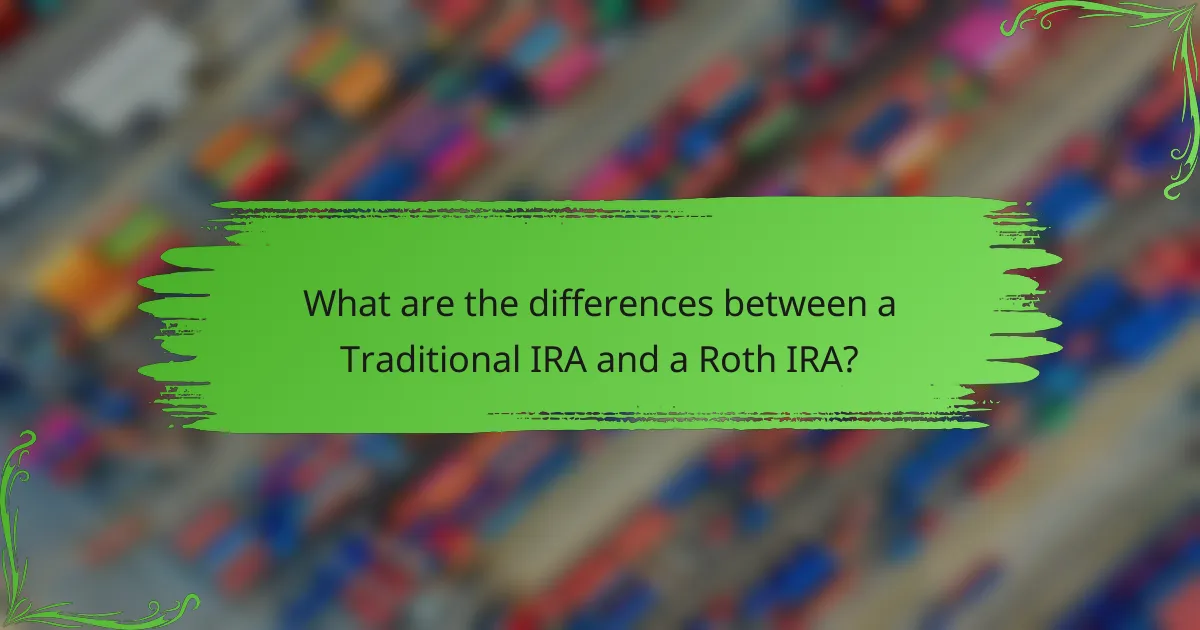A Traditional IRA is a powerful tool for retirement savings, offering tax-deferred growth on your investments until withdrawal. With the ability to make tax-deductible contributions, individuals can lower their taxable income while building a larger nest egg for the future. This combination of benefits makes a Traditional IRA an attractive option for those looking to secure their financial future.

How does a Traditional IRA provide tax-deferred growth?
A Traditional IRA allows your investments to grow without being taxed until you withdraw funds in retirement. This tax-deferred growth means you can potentially accumulate a larger retirement savings balance over time compared to taxable accounts.
Investment growth without immediate tax
With a Traditional IRA, any earnings from investments such as stocks, bonds, or mutual funds are not subject to taxes while they remain in the account. This allows your investments to grow without the burden of immediate tax implications, which can enhance your overall returns.
For example, if you invest $5,000 in a Traditional IRA and it grows to $10,000 over several years, you won’t owe taxes on that growth until you withdraw the funds. This contrasts with taxable accounts where you would pay taxes on any gains each year.
Compounding interest benefits
Tax-deferred growth in a Traditional IRA enables the power of compounding interest to work more effectively. Since you are not paying taxes on your investment gains annually, you can reinvest those earnings, leading to potentially higher growth over time.
Consider this: if your investments earn an average annual return of 6%, the difference in growth between a taxable account and a Traditional IRA can be significant over decades. The longer your money stays invested without tax deductions, the more pronounced the compounding effect becomes.

What are the tax-deductible contributions for a Traditional IRA?
Tax-deductible contributions to a Traditional IRA allow individuals to reduce their taxable income by the amount they contribute, up to certain limits. This feature makes it an attractive option for retirement savings, as it enables tax-deferred growth on investments until withdrawal during retirement.
Eligibility for tax deductions
To qualify for tax deductions on Traditional IRA contributions, individuals must meet specific income and filing status criteria. Generally, if you are not covered by a workplace retirement plan, you can deduct the full contribution regardless of your income. However, if you or your spouse are covered by such a plan, the deduction may be reduced or eliminated based on your modified adjusted gross income (MAGI).
For example, for the tax year 2023, single filers with a MAGI below approximately $73,000 can deduct the full contribution, while those earning between $73,000 and $83,000 may see a reduced deduction. Above $83,000, no deduction is allowed.
Contribution limits for the tax year
The contribution limit for a Traditional IRA is set annually by the IRS. For the tax year 2023, individuals can contribute up to $6,500, or $7,500 if they are aged 50 or older, allowing for catch-up contributions. These limits apply to the total contributions across all Traditional IRAs owned.
It’s essential to keep track of your contributions to avoid exceeding these limits, as excess contributions may incur penalties. Consider setting reminders or using a spreadsheet to monitor your contributions throughout the year.

What are the benefits of a Traditional IRA for retirement savings?
A Traditional IRA offers significant advantages for retirement savings, primarily through tax-deferred growth and the potential for tax-deductible contributions. This means that your investments can grow without immediate tax implications, allowing for potentially larger retirement savings over time.
Long-term financial security
Investing in a Traditional IRA can enhance your long-term financial security by providing a structured way to save for retirement. Contributions may be tax-deductible, which can lower your taxable income in the year you contribute, offering immediate financial relief.
Moreover, the tax-deferred growth allows your investments to compound over time without the burden of annual taxes. This can lead to a significantly larger nest egg when you reach retirement age, as you benefit from the power of compounding interest.
Flexibility in investment choices
A Traditional IRA provides a wide range of investment options, allowing you to tailor your portfolio according to your risk tolerance and financial goals. You can invest in stocks, bonds, mutual funds, and other assets, giving you the flexibility to diversify your investments.
It’s important to regularly review and adjust your investment choices based on market conditions and your retirement timeline. Be mindful of fees associated with different investment options, as these can impact your overall returns. Aim for a balanced approach that aligns with your long-term objectives while managing risk effectively.

How do Traditional IRA contributions affect taxable income?
Contributions to a Traditional IRA can significantly reduce your taxable income for the year in which you make the contributions. This tax-deferred growth allows your investments to compound without immediate tax implications, making it a strategic choice for retirement savings.
Reducing taxable income in the contribution year
When you contribute to a Traditional IRA, the amount you contribute may be deducted from your taxable income, effectively lowering your tax bill for that year. For example, if you contribute $6,000 and your taxable income is $50,000, your new taxable income could be reduced to $44,000, assuming you qualify for the full deduction.
It’s important to note that the deduction may be limited based on your income level and whether you or your spouse are covered by a workplace retirement plan. For 2023, single filers with a modified adjusted gross income (MAGI) above $78,000 may see a reduced deduction, while those above $88,000 are ineligible for a deduction.
Impact on tax brackets
Reducing your taxable income through Traditional IRA contributions can help keep you in a lower tax bracket, which can lead to significant tax savings. For instance, if your income is close to the threshold of a higher tax bracket, contributing to an IRA could prevent you from crossing that line.
Consider the marginal tax rates: if you are in the 22% bracket and your income is reduced to fall into the 12% bracket, you could save substantially on taxes. This strategy is particularly beneficial for those who anticipate being in a lower tax bracket during retirement, as withdrawals from the IRA will be taxed at that lower rate.

What are the withdrawal rules for a Traditional IRA?
Withdrawal rules for a Traditional IRA dictate when and how you can access your funds without incurring penalties. Generally, you can withdraw money penalty-free after reaching age 59½, but early withdrawals may incur taxes and penalties.
Age restrictions and penalties
Withdrawals from a Traditional IRA before age 59½ typically incur a 10% early withdrawal penalty in addition to regular income tax. This means if you withdraw funds early, you will pay taxes on the amount plus an extra penalty, which can significantly reduce your savings.
There are exceptions to this penalty, such as for first-time home purchases, qualified education expenses, or certain medical expenses. However, even with these exceptions, you will still owe income tax on the withdrawn amount.
Qualified distributions
Qualified distributions from a Traditional IRA are those made after you reach age 59½ or due to disability, death, or certain other circumstances. These withdrawals are subject to regular income tax but do not incur the early withdrawal penalty.
To avoid penalties and taxes, ensure that your withdrawals meet the criteria for qualified distributions. It’s advisable to consult with a tax professional to understand the implications of your withdrawals and to plan accordingly for your retirement needs.

What are the differences between a Traditional IRA and a Roth IRA?
A Traditional IRA and a Roth IRA differ primarily in their tax treatment of contributions and withdrawals. With a Traditional IRA, contributions may be tax-deductible, while withdrawals are taxed as income. In contrast, Roth IRA contributions are made with after-tax dollars, allowing for tax-free withdrawals in retirement.
Tax treatment of contributions
Contributions to a Traditional IRA can often be deducted from your taxable income, which can lower your tax bill in the year you contribute. For the 2023 tax year, individuals can contribute up to $6,500, or $7,500 if they are age 50 or older. This means that if you contribute the maximum amount, you could potentially reduce your taxable income by that same amount.
On the other hand, contributions to a Roth IRA are made with after-tax income, meaning you do not receive a tax deduction for your contributions. However, the benefit is that qualified withdrawals during retirement are tax-free, which can be advantageous if you expect to be in a higher tax bracket later.
Withdrawal rules comparison
Withdrawals from a Traditional IRA are generally taxed as ordinary income and are subject to a 10% penalty if taken before age 59½, unless certain exceptions apply. After reaching age 72, account holders must begin taking required minimum distributions (RMDs), which can impact your tax situation in retirement.
In contrast, Roth IRA withdrawals are tax-free and penalty-free if the account has been open for at least five years and you are at least 59½ years old. Additionally, Roth IRAs do not have RMDs during the account holder’s lifetime, allowing for more flexibility in retirement planning. This can be particularly beneficial for those who want to leave assets to heirs or continue growing their investments tax-free.

How can one maximize benefits from a Traditional IRA?
To maximize benefits from a Traditional IRA, focus on tax-deferred growth, tax-deductible contributions, and strategic planning. By understanding contribution limits and timing, you can enhance your retirement savings effectively.
Strategic contribution timing
Timing your contributions to a Traditional IRA can significantly impact your tax savings and overall growth. Contributions can be made up until the tax filing deadline for the previous year, which allows flexibility in planning your finances.
Consider making contributions early in the year to take full advantage of tax-deferred growth. For example, if you contribute the maximum allowed amount, which is often in the range of $6,000 to $7,000 depending on age, you can benefit from compounding interest over a longer period.
Avoid waiting until the last minute to contribute, as this can lead to missed opportunities for growth. Setting up automatic contributions can help ensure you consistently fund your IRA throughout the year.


